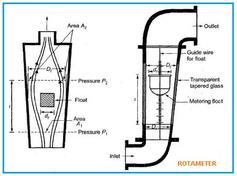Variable Area Flowmeter: Advantages and Disadvantages
Advertisement
This article explores the pros and cons of using a variable area flowmeter, a common device for measuring the flow rate of liquids and gases. We’ll delve into how they work and highlight their benefits and drawbacks.
What is a Variable Area Flowmeter?
A variable area flowmeter is a mechanical device used to measure the volumetric flow rate of fluids and gases. It operates on a simple principle: a fluid flows through a vertical, conical tube, causing a float to move within the tube.
Here’s a breakdown of the key elements:
- Vertical Conical Tube: The core component, this tube widens from bottom to top.
- Mobile Float: This object moves freely within the tube, rising or falling depending on the fluid flow.
- Forces at Play: Three main forces govern the float’s position:
- Weight (W): A constant downward force due to gravity.
- Drag (D) and Buoyancy (B): Upward forces, with drag being variable depending on the fluid flow rate.
- Flow Indication: The height of the float within the tube directly corresponds to the flow rate.
Notably, variable area flowmeters are purely mechanical, meaning they don’t need any external power source to operate, which is a major reason for their popularity.

The rotameter is a very common type of variable area flowmeter. They are known for their low cost, simple design, minimal pressure drop, and wide measurement range with a linear output. For more in-depth information, you can refer to the advantages and disadvantages of a Rotameter.
Advantages of Variable Area Flowmeters
Here’s a look at the benefits of using a variable area flowmeter:
- Cost-Effective: They are generally inexpensive compared to other flow measurement technologies.
- No External Power Required: Being mechanical, they don’t need any electricity to function.
- Versatile: Suitable for measuring the flow of gases, liquids, and even steam.
- Easy Installation: They don’t require straight inlet or outlet sections of pipe, which simplifies their installation.
- Simple Maintenance: Their straightforward design makes them relatively easy to maintain.
Disadvantages of Variable Area Flowmeters
Despite their advantages, variable area flowmeters have some limitations:
- Vertical Mounting: They must be installed in a vertical position to operate correctly.
- Constant Pressure Drop: They experience a constant pressure drop across the meter, which could be a consideration for certain applications.
Advertisement
 T&M
T&M 



